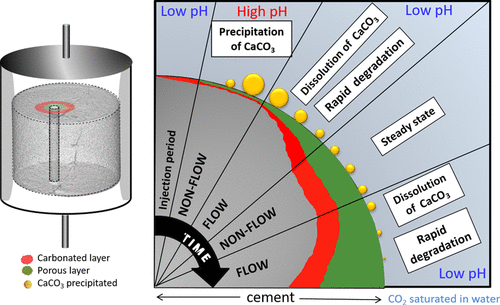当前位置:
X-MOL 学术
›
Environ. Sci. Technol.
›
论文详情
Our official English website, www.x-mol.net, welcomes your
feedback! (Note: you will need to create a separate account there.)
Real Time 3D Observations of Portland Cement Carbonation at CO2 Storage Conditions.
Environmental Science & Technology ( IF 10.8 ) Pub Date : 2020-06-11 , DOI: 10.1021/acs.est.0c00578 Elvia A Chavez Panduro 1, 2 , Benoît Cordonnier 3, 4 , Kamila Gawel 5 , Ingrid Børve 1 , Jaisree Iyer 6 , Susan A Carroll 6 , Leander Michels 1 , Melania Rogowska 7 , Jessica Ann McBeck 3 , Henning Osholm Sørensen 7, 8 , Stuart D C Walsh 9 , François Renard 3, 10 , Alain Gibaud 11 , Malin Torsæter 5 , Dag W Breiby 12, 13
Environmental Science & Technology ( IF 10.8 ) Pub Date : 2020-06-11 , DOI: 10.1021/acs.est.0c00578 Elvia A Chavez Panduro 1, 2 , Benoît Cordonnier 3, 4 , Kamila Gawel 5 , Ingrid Børve 1 , Jaisree Iyer 6 , Susan A Carroll 6 , Leander Michels 1 , Melania Rogowska 7 , Jessica Ann McBeck 3 , Henning Osholm Sørensen 7, 8 , Stuart D C Walsh 9 , François Renard 3, 10 , Alain Gibaud 11 , Malin Torsæter 5 , Dag W Breiby 12, 13
Affiliation

|
Depleted oil reservoirs are considered a viable solution to the global challenge of CO2 storage. A key concern is whether the wells can be suitably sealed with cement to hinder the escape of CO2. Under reservoir conditions, CO2 is in its supercritical state, and the high pressures and temperatures involved make real-time microscopic observations of cement degradation experimentally challenging. Here, we present an in situ 3D dynamic X-ray micro computed tomography (μ-CT) study of well cement carbonation at realistic reservoir stress, pore-pressure, and temperature conditions. The high-resolution time-lapse 3D images allow monitoring the progress of reaction fronts in Portland cement, including density changes, sample deformation, and mineral precipitation and dissolution. By switching between flow and nonflow conditions of CO2-saturated water through cement, we were able to delineate regimes dominated by calcium carbonate precipitation and dissolution. For the first time, we demonstrate experimentally the impact of the flow history on CO2 leakage risk for cement plugging. In-situ μ-CT experiments combined with geochemical modeling provide unique insight into the interactions between CO2 and cement, potentially helping in assessing the risks of CO2 storage in geological reservoirs.
中文翻译:

二氧化碳储存条件下波特兰水泥碳化的实时3D观测。
枯竭的油层被认为是应对全球CO 2储存挑战的可行解决方案。关键问题是井是否可以用水泥适当密封以阻止CO 2逸出。在储层条件下,CO 2处于超临界状态,所涉及的高压和高温使得实时微观观察水泥降解的实验具有挑战性。在这里,我们提出了在实际油藏应力,孔隙压力和温度条件下井水泥碳化的原位3D动态X射线计算机断层扫描(μ-CT)研究。高分辨率延时3D图像可监控波特兰水泥中反应前沿的进展,包括密度变化,样品变形以及矿物沉淀和溶解。通过在CO 2的流动和非流动条件之间切换-通过水泥的饱和水,我们能够描绘出以碳酸钙沉淀和溶解为主的体系。首次,我们通过实验证明了流动历史对水泥堵塞CO 2泄漏风险的影响。原位μ-CT实验与地球化学建模相结合,可提供有关CO 2与水泥之间相互作用的独特见解,从而有可能帮助评估地质储层中CO 2储存的风险。
更新日期:2020-07-07
中文翻译:

二氧化碳储存条件下波特兰水泥碳化的实时3D观测。
枯竭的油层被认为是应对全球CO 2储存挑战的可行解决方案。关键问题是井是否可以用水泥适当密封以阻止CO 2逸出。在储层条件下,CO 2处于超临界状态,所涉及的高压和高温使得实时微观观察水泥降解的实验具有挑战性。在这里,我们提出了在实际油藏应力,孔隙压力和温度条件下井水泥碳化的原位3D动态X射线计算机断层扫描(μ-CT)研究。高分辨率延时3D图像可监控波特兰水泥中反应前沿的进展,包括密度变化,样品变形以及矿物沉淀和溶解。通过在CO 2的流动和非流动条件之间切换-通过水泥的饱和水,我们能够描绘出以碳酸钙沉淀和溶解为主的体系。首次,我们通过实验证明了流动历史对水泥堵塞CO 2泄漏风险的影响。原位μ-CT实验与地球化学建模相结合,可提供有关CO 2与水泥之间相互作用的独特见解,从而有可能帮助评估地质储层中CO 2储存的风险。










































 京公网安备 11010802027423号
京公网安备 11010802027423号